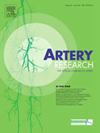High Systolic Blood Pressure is Associated with Increased Cardio-ankle Vascular Index in the Elderly
IF 1.6
4区 医学
Q4 PERIPHERAL VASCULAR DISEASE
引用次数: 1
Abstract
Background: Increased arterial stiffness caused by elevated Blood Pressure (BP) can be indicated by the Cardio-ankle Vascular Index (CAVI). However, the relationship between arterial stiffness and BP is complex. In addition, changes in BP may contribute to increased risk of cardiovascular disease associated with abnormal lipid profiles. So far, results from published studies have been inconclusive. Objectives: To evaluate lipid profiles and BP, and their association with CAVI values in elderly participants. Methods: The study included 95 elderly Thai individuals. Anthropometric data, lipid profiles, and BP and CAVI values were established. Participants were then divided into low-CAVI (CAVI < 9, n = 50) and high-CAVI groups (CAVI ≥ 9, n = 45). Stepwise linear and logistic regression models were used. Results: The high-CAVI group had significantly higher BP and hypertension levels, than the low-CAVI group. The mean age of the high-CAVI group was also higher (≥65 years). CAVI value was positively correlated with Systolic Blood Pressure (SBP) and Pulse Pressure (PP) in the high-CAVI group. Stepwise multiple regression analysis showed SBP ( b = 0.43, p < 0.01) and hip circumference ( b = −0.23, p = 0.01) were associated with CAVI values. Logistic regression of the high-CAVI indices showed that the Odds Ratios (ORs) for the factors of age ≥65 years, obesity, hypertension老年人高收缩压与心踝血管指数升高相关
背景:血压升高引起的动脉硬化增加可以通过心踝血管指数(CAVI)来指示。然而,动脉硬化和血压之间的关系是复杂的。此外,血压的变化可能会增加与血脂异常相关的心血管疾病的风险。到目前为止,发表的研究结果还没有定论。目的:评估老年参与者的血脂谱和血压,以及它们与CAVI值的关系。方法:该研究包括95名泰国老年人。建立了人体测量数据、脂质图谱、BP和CAVI值。然后将参与者分为CAVI低组(CAVI<9,n=50)和CAVI高组(CAV≥9,n=45)。采用逐步线性和逻辑回归模型。结果:高CAVI组的血压和高血压水平明显高于低CAVI组。CAVI高组的平均年龄也较高(≥65岁)。高CAVI组的CAVI值与收缩压(SBP)和脉压(PP)呈正相关。逐步多元回归分析显示,收缩压(b=0.43,p<0.01)和臀围(b=-0.23,p=0.01)与CAVI值相关。高CAVI指数的Logistic回归显示,年龄≥65岁、肥胖、高血压等因素的比值比(OR)
本文章由计算机程序翻译,如有差异,请以英文原文为准。
求助全文
约1分钟内获得全文
求助全文
来源期刊

Artery Research
Medicine-Cardiology and Cardiovascular Medicine
CiteScore
1.70
自引率
16.70%
发文量
14
审稿时长
13 weeks
期刊介绍:
Artery Research is the official journal of the Association for Research into Arterial Structure and Physiology (ARTERY) which promotes the advancement of knowledge and dissemination of information concerning the pathophysiology, epidemiology, detection, investigation and treatment of arterial structure and function. The journal publishes original research articles, review articles, perspectives, case-studies, letters to the Editor, short communications and images. All submitted material is subject to a strict peer-review process.
 求助内容:
求助内容: 应助结果提醒方式:
应助结果提醒方式:


